User Center Design
VerifiedAdded on 2023/04/11
|10
|1906
|479
AI Summary
This report discusses the importance of user-centered design in developing digital systems and explores current design trends and challenges. It also provides justification for the use of HCI and UCD approaches in system design.
Contribute Materials
Your contribution can guide someone’s learning journey. Share your
documents today.
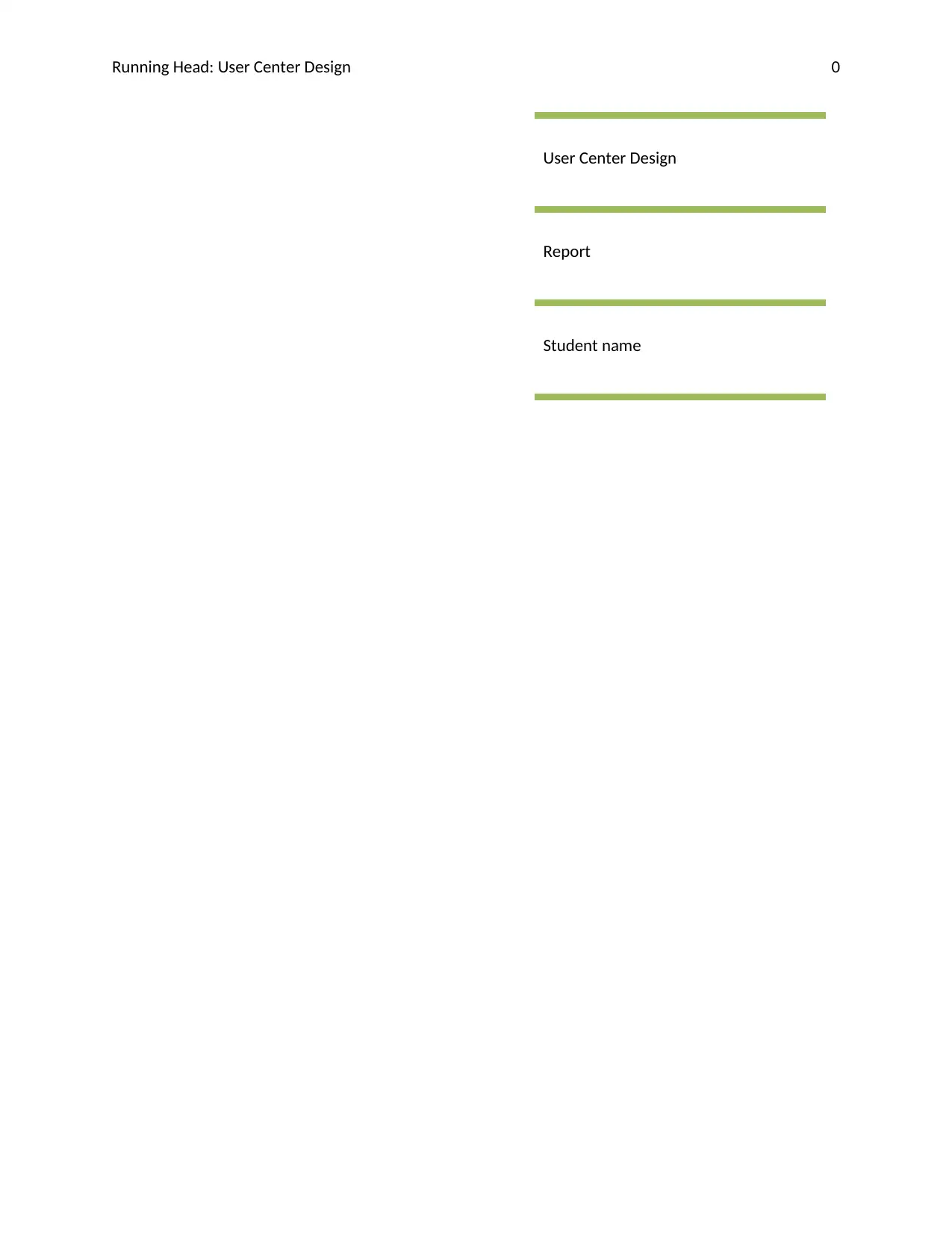
Running Head: User Center Design 0
User Center Design
Report
Student name
User Center Design
Report
Student name
Secure Best Marks with AI Grader
Need help grading? Try our AI Grader for instant feedback on your assignments.
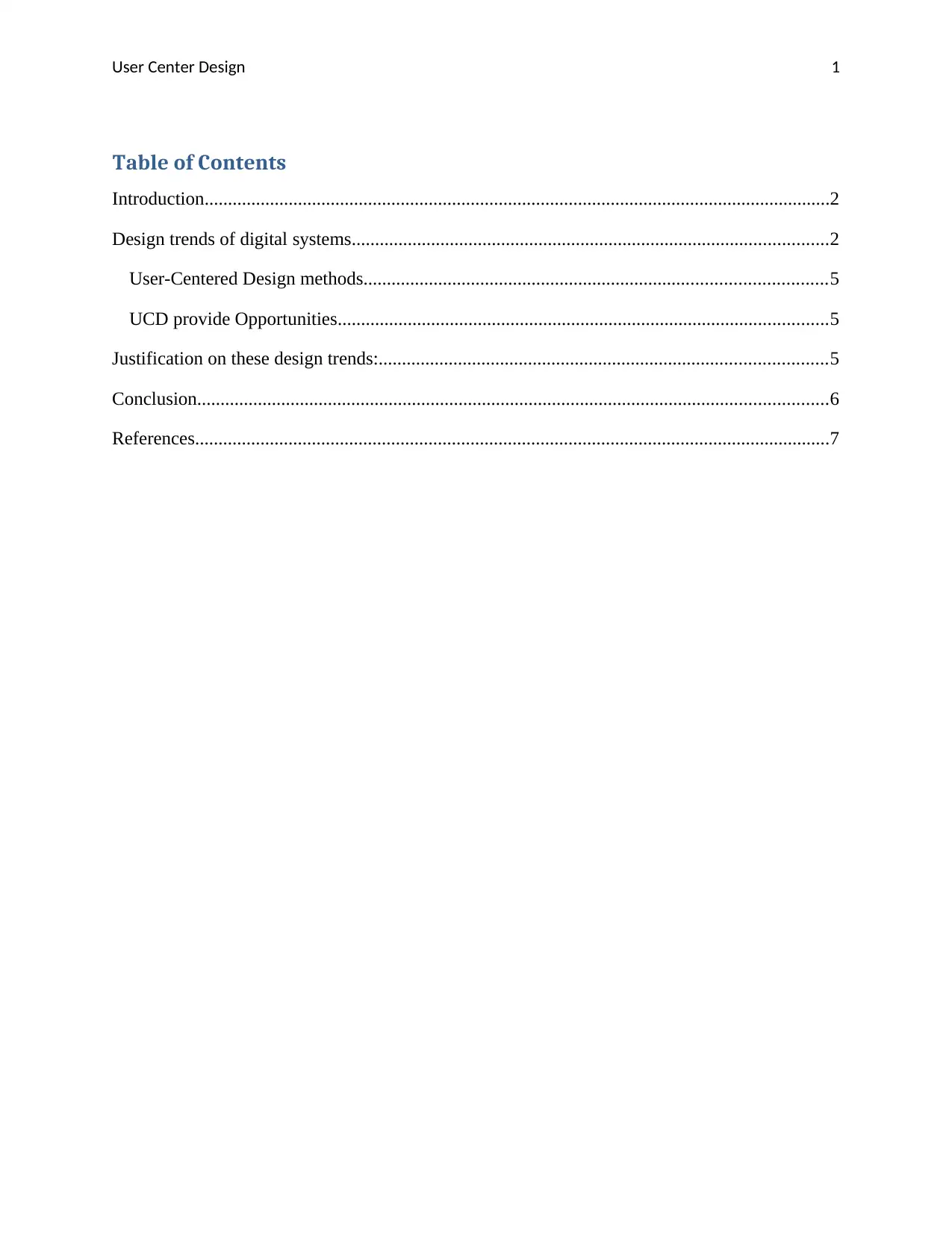
User Center Design 1
Table of Contents
Introduction......................................................................................................................................2
Design trends of digital systems......................................................................................................2
User-Centered Design methods...................................................................................................5
UCD provide Opportunities.........................................................................................................5
Justification on these design trends:................................................................................................5
Conclusion.......................................................................................................................................6
References........................................................................................................................................7
Table of Contents
Introduction......................................................................................................................................2
Design trends of digital systems......................................................................................................2
User-Centered Design methods...................................................................................................5
UCD provide Opportunities.........................................................................................................5
Justification on these design trends:................................................................................................5
Conclusion.......................................................................................................................................6
References........................................................................................................................................7

User Center Design 2
Introduction
In present era, most of the systems are based on latest technologies, such as cloud computing, big
data, and many others. It is necessary to design a digital system involving Human Computer
Interface (referred as HCI) and user-centered design (UCD) as well as current design trends
(Baun, et al., 2011).
It is a way to provide better advantages to the organization and system to attract the entire person
and provide desired benefits. In this report, the description is given about the need for design
guideline to develop a digital system. It will also explain about the current trends and the
challenges, which the designers have been has facing long in creating digital systems (Benyon,
2014).
This repot will explain about the design trends that are useful to improve the usability of related
digital systems for different purposes. The later section of this report provides justification on the
value of these design trends of improved usability of digital systems.
Design trends of digital systems
From last two decades, Technologies are changes in every field and emergence of technologies
in different fields to reduce manual work. It increases the profit and productivity of the system.
In present era, cloud computing provides solutions of all those things that are required by the
consumers. The best example of that is Internet of Things (IoT) (Bhagat, 2012).
IoT is uses Internet to connect different devices for data collection and it use data mining
techniques on that data for decision-making. There are HCI and UCD, and many other design
trends, which provides a desired outcomes based on the user’s needs (Blakstad & Andreassen,
2016).
Cloud computing is providing base to the all the working process of IoT system. IoT is a best
example, which uses different types of established digital system to provide desired outcome
with the help of latest technologies, such as cloud computing services, big data, machine
learning, and many others (Ceselli, et al., 2017).
Introduction
In present era, most of the systems are based on latest technologies, such as cloud computing, big
data, and many others. It is necessary to design a digital system involving Human Computer
Interface (referred as HCI) and user-centered design (UCD) as well as current design trends
(Baun, et al., 2011).
It is a way to provide better advantages to the organization and system to attract the entire person
and provide desired benefits. In this report, the description is given about the need for design
guideline to develop a digital system. It will also explain about the current trends and the
challenges, which the designers have been has facing long in creating digital systems (Benyon,
2014).
This repot will explain about the design trends that are useful to improve the usability of related
digital systems for different purposes. The later section of this report provides justification on the
value of these design trends of improved usability of digital systems.
Design trends of digital systems
From last two decades, Technologies are changes in every field and emergence of technologies
in different fields to reduce manual work. It increases the profit and productivity of the system.
In present era, cloud computing provides solutions of all those things that are required by the
consumers. The best example of that is Internet of Things (IoT) (Bhagat, 2012).
IoT is uses Internet to connect different devices for data collection and it use data mining
techniques on that data for decision-making. There are HCI and UCD, and many other design
trends, which provides a desired outcomes based on the user’s needs (Blakstad & Andreassen,
2016).
Cloud computing is providing base to the all the working process of IoT system. IoT is a best
example, which uses different types of established digital system to provide desired outcome
with the help of latest technologies, such as cloud computing services, big data, machine
learning, and many others (Ceselli, et al., 2017).

User Center Design 3
Customers are requires different things with high security of resources and the proper graphical
interface to understand and manage all the processes. Design trends are changes according to
requirements of the consumers (Chen & Zhao, 2012).
Source: ( Gladkiy, 2018)
Present technologies are uses previous hardware and softwares to create budget-oriented system.
Digital systems are having proper details of user experience and need to fulfill the business goals
(Dinh, et al., 2013).
IoT is having many applications in which it uses Bluetooth, RFID, NFC, and Internet to
designing a system. These are the applications of IoT, which is based on the HCI and UCD:
Smart home, Wearable, Smart City, Smart grids, Industrial internet, connected car, Connected
Health, Smart retail, Smart supply chain, Smart farming, and many others (Dinh, et al., 2013).
All those systems are designed using cloud computing, Internet, and other technologies. IoT is
uses those devices, which is require low power to work. Bluetooth is an example of this, which is
consuming low power as well as non-IP communication (Garg, et al., 2013). A digital system has
designed to meet business goals as well as increase revenue from that system. It can happen
through the technological changes and capabilities of software as well as hardware. However,
end user is not present in design approach, which is an essential part of this process (Hevner &
Chatterjee, 2010).
Customers are requires different things with high security of resources and the proper graphical
interface to understand and manage all the processes. Design trends are changes according to
requirements of the consumers (Chen & Zhao, 2012).
Source: ( Gladkiy, 2018)
Present technologies are uses previous hardware and softwares to create budget-oriented system.
Digital systems are having proper details of user experience and need to fulfill the business goals
(Dinh, et al., 2013).
IoT is having many applications in which it uses Bluetooth, RFID, NFC, and Internet to
designing a system. These are the applications of IoT, which is based on the HCI and UCD:
Smart home, Wearable, Smart City, Smart grids, Industrial internet, connected car, Connected
Health, Smart retail, Smart supply chain, Smart farming, and many others (Dinh, et al., 2013).
All those systems are designed using cloud computing, Internet, and other technologies. IoT is
uses those devices, which is require low power to work. Bluetooth is an example of this, which is
consuming low power as well as non-IP communication (Garg, et al., 2013). A digital system has
designed to meet business goals as well as increase revenue from that system. It can happen
through the technological changes and capabilities of software as well as hardware. However,
end user is not present in design approach, which is an essential part of this process (Hevner &
Chatterjee, 2010).
Secure Best Marks with AI Grader
Need help grading? Try our AI Grader for instant feedback on your assignments.
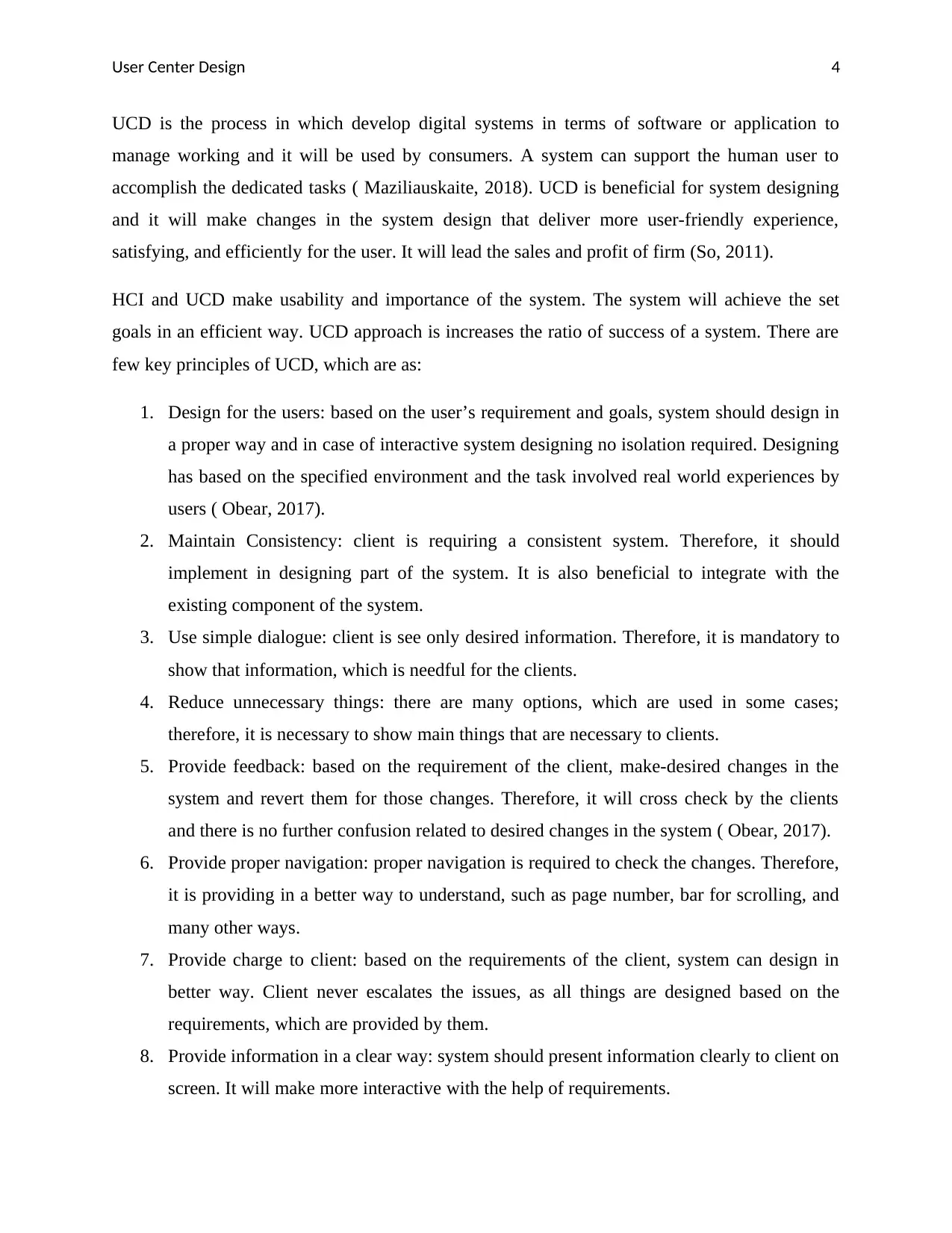
User Center Design 4
UCD is the process in which develop digital systems in terms of software or application to
manage working and it will be used by consumers. A system can support the human user to
accomplish the dedicated tasks ( Maziliauskaite, 2018). UCD is beneficial for system designing
and it will make changes in the system design that deliver more user-friendly experience,
satisfying, and efficiently for the user. It will lead the sales and profit of firm (So, 2011).
HCI and UCD make usability and importance of the system. The system will achieve the set
goals in an efficient way. UCD approach is increases the ratio of success of a system. There are
few key principles of UCD, which are as:
1. Design for the users: based on the user’s requirement and goals, system should design in
a proper way and in case of interactive system designing no isolation required. Designing
has based on the specified environment and the task involved real world experiences by
users ( Obear, 2017).
2. Maintain Consistency: client is requiring a consistent system. Therefore, it should
implement in designing part of the system. It is also beneficial to integrate with the
existing component of the system.
3. Use simple dialogue: client is see only desired information. Therefore, it is mandatory to
show that information, which is needful for the clients.
4. Reduce unnecessary things: there are many options, which are used in some cases;
therefore, it is necessary to show main things that are necessary to clients.
5. Provide feedback: based on the requirement of the client, make-desired changes in the
system and revert them for those changes. Therefore, it will cross check by the clients
and there is no further confusion related to desired changes in the system ( Obear, 2017).
6. Provide proper navigation: proper navigation is required to check the changes. Therefore,
it is providing in a better way to understand, such as page number, bar for scrolling, and
many other ways.
7. Provide charge to client: based on the requirements of the client, system can design in
better way. Client never escalates the issues, as all things are designed based on the
requirements, which are provided by them.
8. Provide information in a clear way: system should present information clearly to client on
screen. It will make more interactive with the help of requirements.
UCD is the process in which develop digital systems in terms of software or application to
manage working and it will be used by consumers. A system can support the human user to
accomplish the dedicated tasks ( Maziliauskaite, 2018). UCD is beneficial for system designing
and it will make changes in the system design that deliver more user-friendly experience,
satisfying, and efficiently for the user. It will lead the sales and profit of firm (So, 2011).
HCI and UCD make usability and importance of the system. The system will achieve the set
goals in an efficient way. UCD approach is increases the ratio of success of a system. There are
few key principles of UCD, which are as:
1. Design for the users: based on the user’s requirement and goals, system should design in
a proper way and in case of interactive system designing no isolation required. Designing
has based on the specified environment and the task involved real world experiences by
users ( Obear, 2017).
2. Maintain Consistency: client is requiring a consistent system. Therefore, it should
implement in designing part of the system. It is also beneficial to integrate with the
existing component of the system.
3. Use simple dialogue: client is see only desired information. Therefore, it is mandatory to
show that information, which is needful for the clients.
4. Reduce unnecessary things: there are many options, which are used in some cases;
therefore, it is necessary to show main things that are necessary to clients.
5. Provide feedback: based on the requirement of the client, make-desired changes in the
system and revert them for those changes. Therefore, it will cross check by the clients
and there is no further confusion related to desired changes in the system ( Obear, 2017).
6. Provide proper navigation: proper navigation is required to check the changes. Therefore,
it is providing in a better way to understand, such as page number, bar for scrolling, and
many other ways.
7. Provide charge to client: based on the requirements of the client, system can design in
better way. Client never escalates the issues, as all things are designed based on the
requirements, which are provided by them.
8. Provide information in a clear way: system should present information clearly to client on
screen. It will make more interactive with the help of requirements.
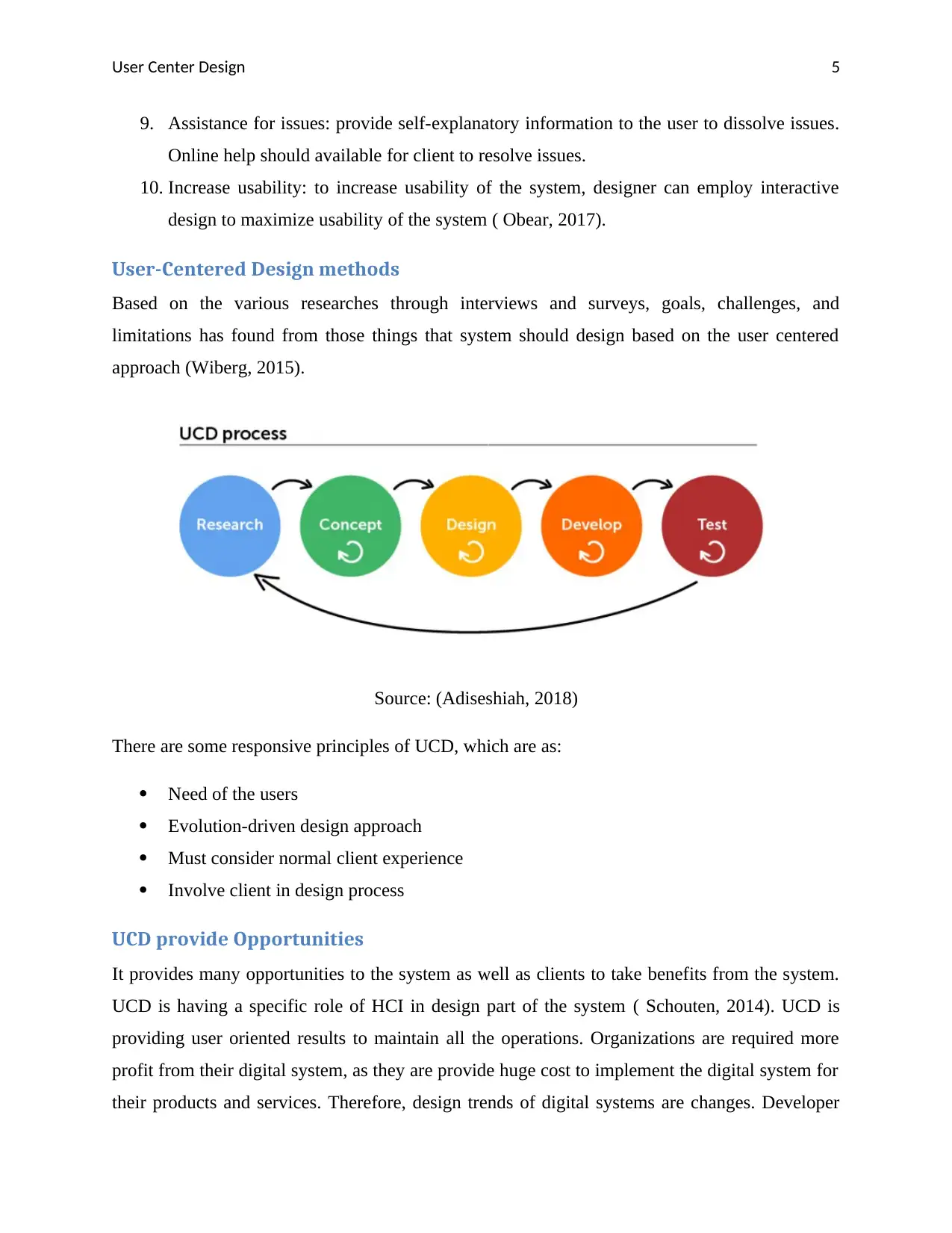
User Center Design 5
9. Assistance for issues: provide self-explanatory information to the user to dissolve issues.
Online help should available for client to resolve issues.
10. Increase usability: to increase usability of the system, designer can employ interactive
design to maximize usability of the system ( Obear, 2017).
User-Centered Design methods
Based on the various researches through interviews and surveys, goals, challenges, and
limitations has found from those things that system should design based on the user centered
approach (Wiberg, 2015).
Source: (Adiseshiah, 2018)
There are some responsive principles of UCD, which are as:
Need of the users
Evolution-driven design approach
Must consider normal client experience
Involve client in design process
UCD provide Opportunities
It provides many opportunities to the system as well as clients to take benefits from the system.
UCD is having a specific role of HCI in design part of the system ( Schouten, 2014). UCD is
providing user oriented results to maintain all the operations. Organizations are required more
profit from their digital system, as they are provide huge cost to implement the digital system for
their products and services. Therefore, design trends of digital systems are changes. Developer
9. Assistance for issues: provide self-explanatory information to the user to dissolve issues.
Online help should available for client to resolve issues.
10. Increase usability: to increase usability of the system, designer can employ interactive
design to maximize usability of the system ( Obear, 2017).
User-Centered Design methods
Based on the various researches through interviews and surveys, goals, challenges, and
limitations has found from those things that system should design based on the user centered
approach (Wiberg, 2015).
Source: (Adiseshiah, 2018)
There are some responsive principles of UCD, which are as:
Need of the users
Evolution-driven design approach
Must consider normal client experience
Involve client in design process
UCD provide Opportunities
It provides many opportunities to the system as well as clients to take benefits from the system.
UCD is having a specific role of HCI in design part of the system ( Schouten, 2014). UCD is
providing user oriented results to maintain all the operations. Organizations are required more
profit from their digital system, as they are provide huge cost to implement the digital system for
their products and services. Therefore, design trends of digital systems are changes. Developer
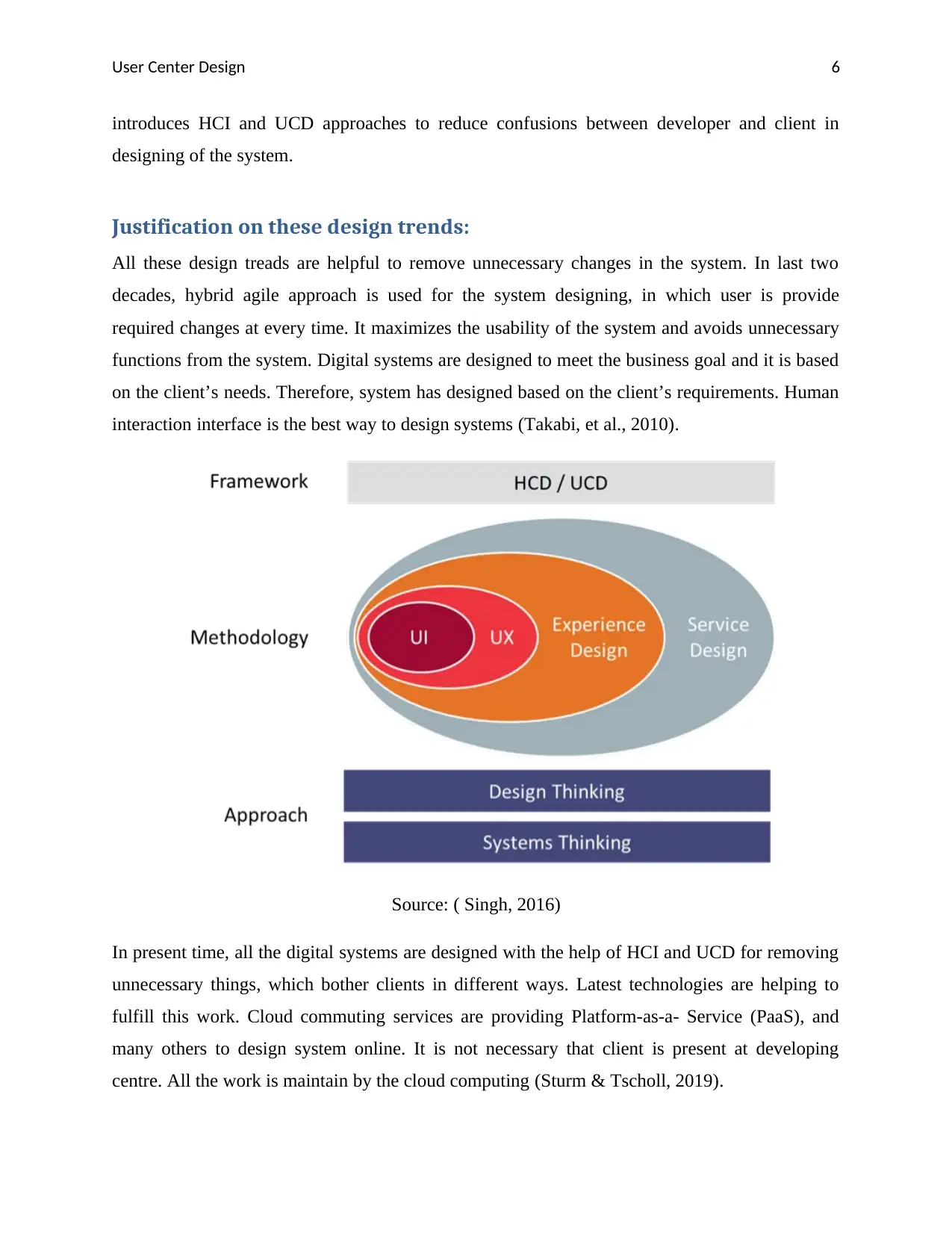
User Center Design 6
introduces HCI and UCD approaches to reduce confusions between developer and client in
designing of the system.
Justification on these design trends:
All these design treads are helpful to remove unnecessary changes in the system. In last two
decades, hybrid agile approach is used for the system designing, in which user is provide
required changes at every time. It maximizes the usability of the system and avoids unnecessary
functions from the system. Digital systems are designed to meet the business goal and it is based
on the client’s needs. Therefore, system has designed based on the client’s requirements. Human
interaction interface is the best way to design systems (Takabi, et al., 2010).
Source: ( Singh, 2016)
In present time, all the digital systems are designed with the help of HCI and UCD for removing
unnecessary things, which bother clients in different ways. Latest technologies are helping to
fulfill this work. Cloud commuting services are providing Platform-as-a- Service (PaaS), and
many others to design system online. It is not necessary that client is present at developing
centre. All the work is maintain by the cloud computing (Sturm & Tscholl, 2019).
introduces HCI and UCD approaches to reduce confusions between developer and client in
designing of the system.
Justification on these design trends:
All these design treads are helpful to remove unnecessary changes in the system. In last two
decades, hybrid agile approach is used for the system designing, in which user is provide
required changes at every time. It maximizes the usability of the system and avoids unnecessary
functions from the system. Digital systems are designed to meet the business goal and it is based
on the client’s needs. Therefore, system has designed based on the client’s requirements. Human
interaction interface is the best way to design systems (Takabi, et al., 2010).
Source: ( Singh, 2016)
In present time, all the digital systems are designed with the help of HCI and UCD for removing
unnecessary things, which bother clients in different ways. Latest technologies are helping to
fulfill this work. Cloud commuting services are providing Platform-as-a- Service (PaaS), and
many others to design system online. It is not necessary that client is present at developing
centre. All the work is maintain by the cloud computing (Sturm & Tscholl, 2019).
Paraphrase This Document
Need a fresh take? Get an instant paraphrase of this document with our AI Paraphraser
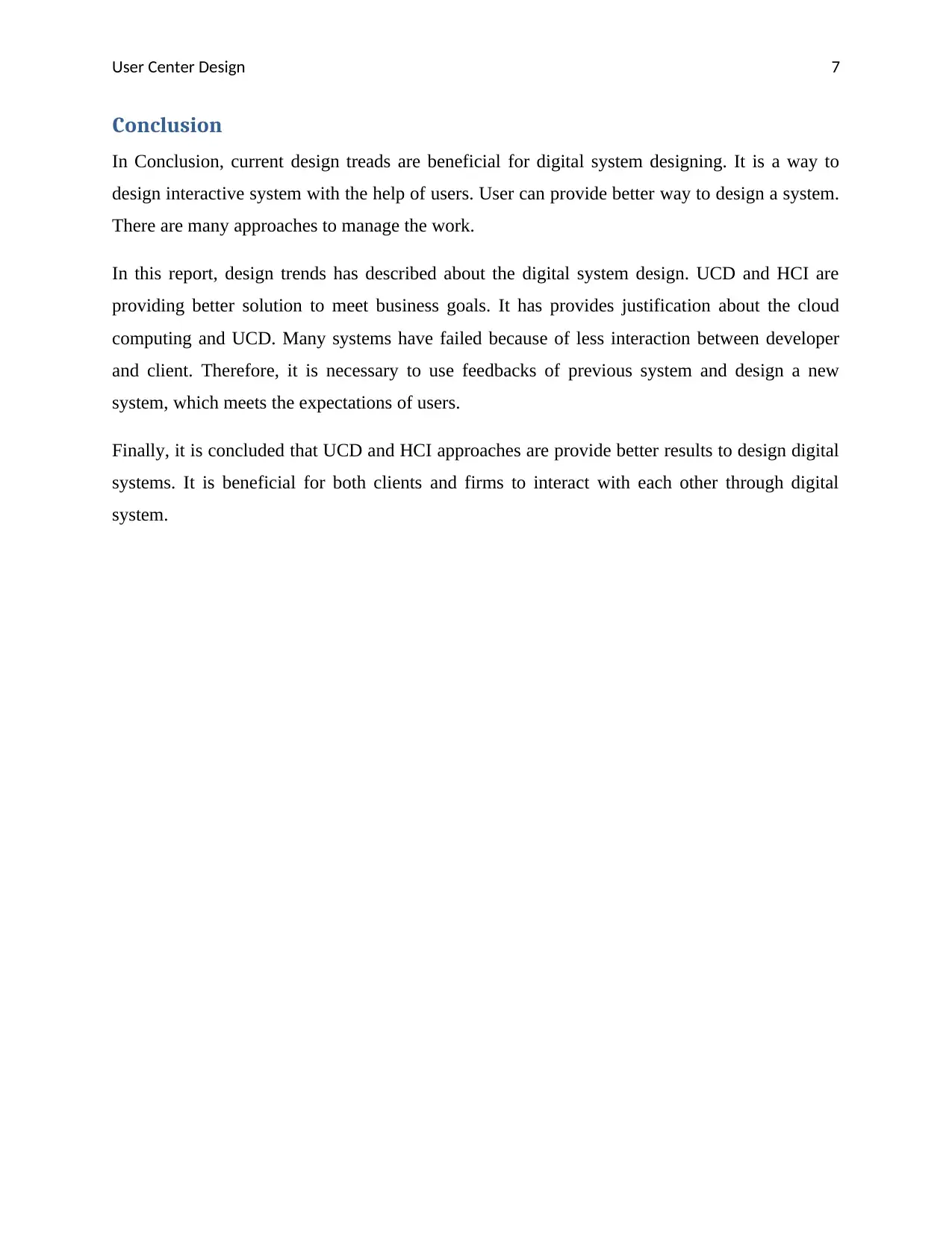
User Center Design 7
Conclusion
In Conclusion, current design treads are beneficial for digital system designing. It is a way to
design interactive system with the help of users. User can provide better way to design a system.
There are many approaches to manage the work.
In this report, design trends has described about the digital system design. UCD and HCI are
providing better solution to meet business goals. It has provides justification about the cloud
computing and UCD. Many systems have failed because of less interaction between developer
and client. Therefore, it is necessary to use feedbacks of previous system and design a new
system, which meets the expectations of users.
Finally, it is concluded that UCD and HCI approaches are provide better results to design digital
systems. It is beneficial for both clients and firms to interact with each other through digital
system.
Conclusion
In Conclusion, current design treads are beneficial for digital system designing. It is a way to
design interactive system with the help of users. User can provide better way to design a system.
There are many approaches to manage the work.
In this report, design trends has described about the digital system design. UCD and HCI are
providing better solution to meet business goals. It has provides justification about the cloud
computing and UCD. Many systems have failed because of less interaction between developer
and client. Therefore, it is necessary to use feedbacks of previous system and design a new
system, which meets the expectations of users.
Finally, it is concluded that UCD and HCI approaches are provide better results to design digital
systems. It is beneficial for both clients and firms to interact with each other through digital
system.
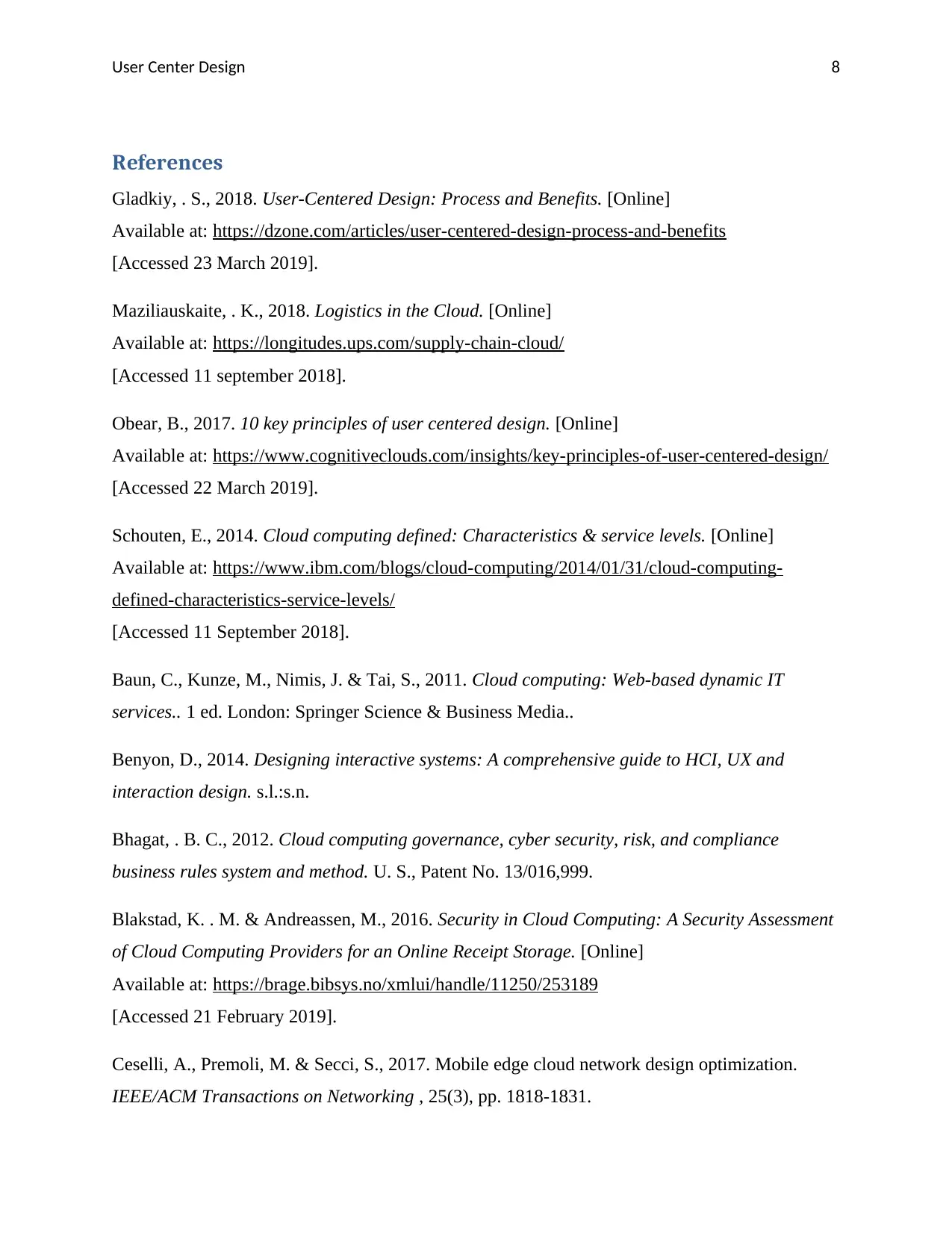
User Center Design 8
References
Gladkiy, . S., 2018. User-Centered Design: Process and Benefits. [Online]
Available at: https://dzone.com/articles/user-centered-design-process-and-benefits
[Accessed 23 March 2019].
Maziliauskaite, . K., 2018. Logistics in the Cloud. [Online]
Available at: https://longitudes.ups.com/supply-chain-cloud/
[Accessed 11 september 2018].
Obear, B., 2017. 10 key principles of user centered design. [Online]
Available at: https://www.cognitiveclouds.com/insights/key-principles-of-user-centered-design/
[Accessed 22 March 2019].
Schouten, E., 2014. Cloud computing defined: Characteristics & service levels. [Online]
Available at: https://www.ibm.com/blogs/cloud-computing/2014/01/31/cloud-computing-
defined-characteristics-service-levels/
[Accessed 11 September 2018].
Baun, C., Kunze, M., Nimis, J. & Tai, S., 2011. Cloud computing: Web-based dynamic IT
services.. 1 ed. London: Springer Science & Business Media..
Benyon, D., 2014. Designing interactive systems: A comprehensive guide to HCI, UX and
interaction design. s.l.:s.n.
Bhagat, . B. C., 2012. Cloud computing governance, cyber security, risk, and compliance
business rules system and method. U. S., Patent No. 13/016,999.
Blakstad, K. . M. & Andreassen, M., 2016. Security in Cloud Computing: A Security Assessment
of Cloud Computing Providers for an Online Receipt Storage. [Online]
Available at: https://brage.bibsys.no/xmlui/handle/11250/253189
[Accessed 21 February 2019].
Ceselli, A., Premoli, M. & Secci, S., 2017. Mobile edge cloud network design optimization.
IEEE/ACM Transactions on Networking , 25(3), pp. 1818-1831.
References
Gladkiy, . S., 2018. User-Centered Design: Process and Benefits. [Online]
Available at: https://dzone.com/articles/user-centered-design-process-and-benefits
[Accessed 23 March 2019].
Maziliauskaite, . K., 2018. Logistics in the Cloud. [Online]
Available at: https://longitudes.ups.com/supply-chain-cloud/
[Accessed 11 september 2018].
Obear, B., 2017. 10 key principles of user centered design. [Online]
Available at: https://www.cognitiveclouds.com/insights/key-principles-of-user-centered-design/
[Accessed 22 March 2019].
Schouten, E., 2014. Cloud computing defined: Characteristics & service levels. [Online]
Available at: https://www.ibm.com/blogs/cloud-computing/2014/01/31/cloud-computing-
defined-characteristics-service-levels/
[Accessed 11 September 2018].
Baun, C., Kunze, M., Nimis, J. & Tai, S., 2011. Cloud computing: Web-based dynamic IT
services.. 1 ed. London: Springer Science & Business Media..
Benyon, D., 2014. Designing interactive systems: A comprehensive guide to HCI, UX and
interaction design. s.l.:s.n.
Bhagat, . B. C., 2012. Cloud computing governance, cyber security, risk, and compliance
business rules system and method. U. S., Patent No. 13/016,999.
Blakstad, K. . M. & Andreassen, M., 2016. Security in Cloud Computing: A Security Assessment
of Cloud Computing Providers for an Online Receipt Storage. [Online]
Available at: https://brage.bibsys.no/xmlui/handle/11250/253189
[Accessed 21 February 2019].
Ceselli, A., Premoli, M. & Secci, S., 2017. Mobile edge cloud network design optimization.
IEEE/ACM Transactions on Networking , 25(3), pp. 1818-1831.
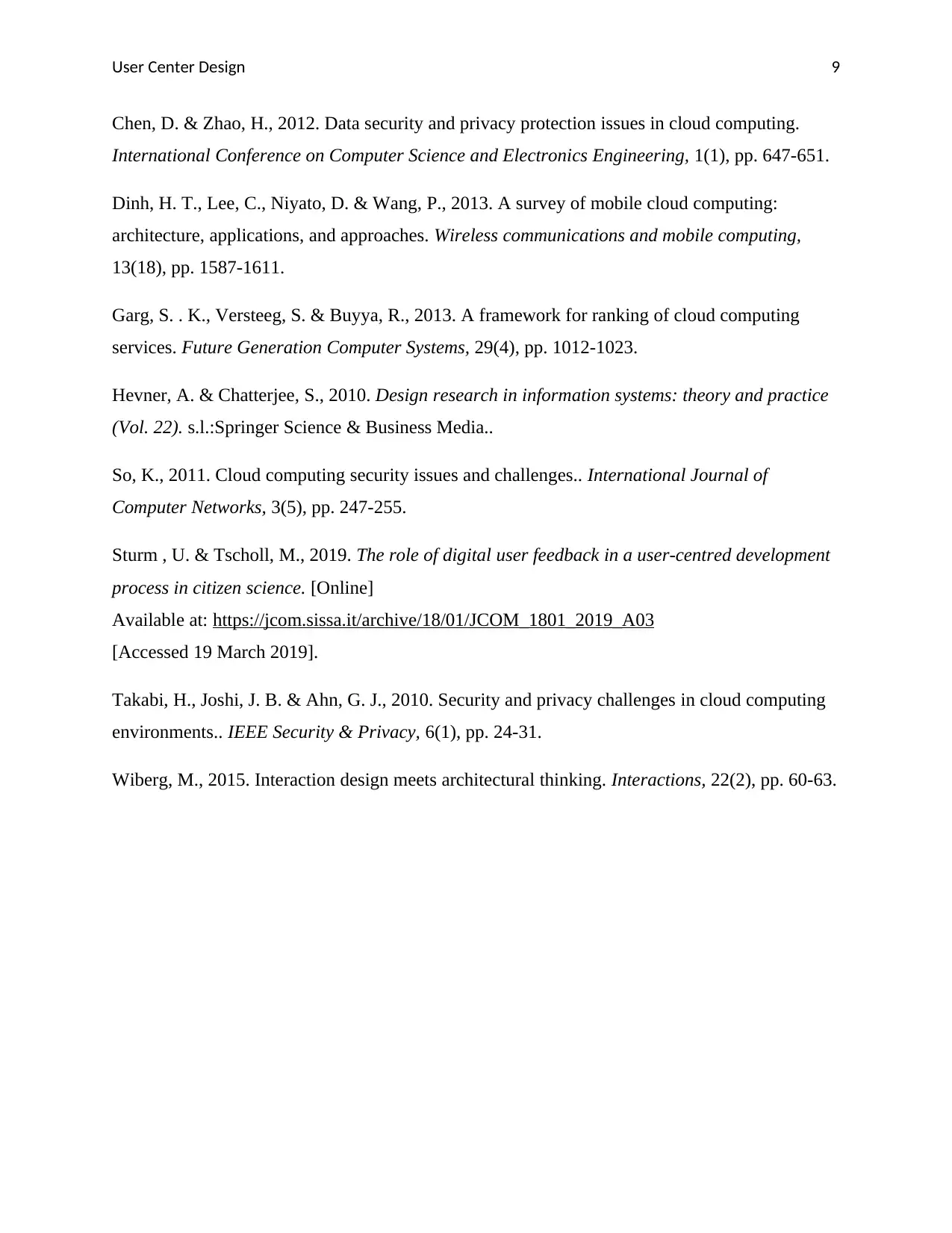
User Center Design 9
Chen, D. & Zhao, H., 2012. Data security and privacy protection issues in cloud computing.
International Conference on Computer Science and Electronics Engineering, 1(1), pp. 647-651.
Dinh, H. T., Lee, C., Niyato, D. & Wang, P., 2013. A survey of mobile cloud computing:
architecture, applications, and approaches. Wireless communications and mobile computing,
13(18), pp. 1587-1611.
Garg, S. . K., Versteeg, S. & Buyya, R., 2013. A framework for ranking of cloud computing
services. Future Generation Computer Systems, 29(4), pp. 1012-1023.
Hevner, A. & Chatterjee, S., 2010. Design research in information systems: theory and practice
(Vol. 22). s.l.:Springer Science & Business Media..
So, K., 2011. Cloud computing security issues and challenges.. International Journal of
Computer Networks, 3(5), pp. 247-255.
Sturm , U. & Tscholl, M., 2019. The role of digital user feedback in a user-centred development
process in citizen science. [Online]
Available at: https://jcom.sissa.it/archive/18/01/JCOM_1801_2019_A03
[Accessed 19 March 2019].
Takabi, H., Joshi, J. B. & Ahn, G. J., 2010. Security and privacy challenges in cloud computing
environments.. IEEE Security & Privacy, 6(1), pp. 24-31.
Wiberg, M., 2015. Interaction design meets architectural thinking. Interactions, 22(2), pp. 60-63.
Chen, D. & Zhao, H., 2012. Data security and privacy protection issues in cloud computing.
International Conference on Computer Science and Electronics Engineering, 1(1), pp. 647-651.
Dinh, H. T., Lee, C., Niyato, D. & Wang, P., 2013. A survey of mobile cloud computing:
architecture, applications, and approaches. Wireless communications and mobile computing,
13(18), pp. 1587-1611.
Garg, S. . K., Versteeg, S. & Buyya, R., 2013. A framework for ranking of cloud computing
services. Future Generation Computer Systems, 29(4), pp. 1012-1023.
Hevner, A. & Chatterjee, S., 2010. Design research in information systems: theory and practice
(Vol. 22). s.l.:Springer Science & Business Media..
So, K., 2011. Cloud computing security issues and challenges.. International Journal of
Computer Networks, 3(5), pp. 247-255.
Sturm , U. & Tscholl, M., 2019. The role of digital user feedback in a user-centred development
process in citizen science. [Online]
Available at: https://jcom.sissa.it/archive/18/01/JCOM_1801_2019_A03
[Accessed 19 March 2019].
Takabi, H., Joshi, J. B. & Ahn, G. J., 2010. Security and privacy challenges in cloud computing
environments.. IEEE Security & Privacy, 6(1), pp. 24-31.
Wiberg, M., 2015. Interaction design meets architectural thinking. Interactions, 22(2), pp. 60-63.
1 out of 10
Related Documents
Your All-in-One AI-Powered Toolkit for Academic Success.
+13062052269
info@desklib.com
Available 24*7 on WhatsApp / Email
![[object Object]](/_next/static/media/star-bottom.7253800d.svg)
Unlock your academic potential
© 2024 | Zucol Services PVT LTD | All rights reserved.





